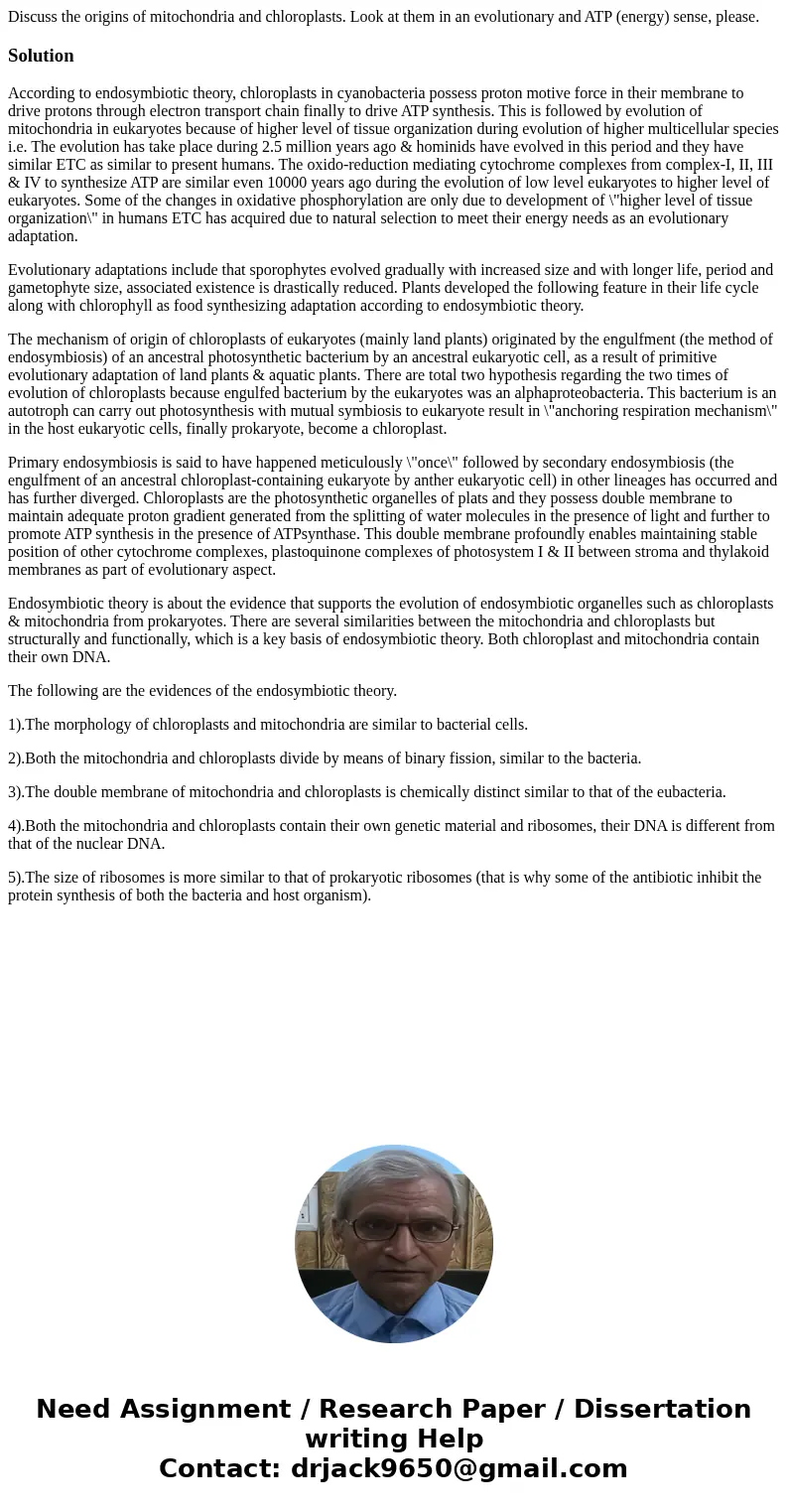Discuss the origins of mitochondria and chloroplasts Look at
Discuss the origins of mitochondria and chloroplasts. Look at them in an evolutionary and ATP (energy) sense, please.
Solution
According to endosymbiotic theory, chloroplasts in cyanobacteria possess proton motive force in their membrane to drive protons through electron transport chain finally to drive ATP synthesis. This is followed by evolution of mitochondria in eukaryotes because of higher level of tissue organization during evolution of higher multicellular species i.e. The evolution has take place during 2.5 million years ago & hominids have evolved in this period and they have similar ETC as similar to present humans. The oxido-reduction mediating cytochrome complexes from complex-I, II, III & IV to synthesize ATP are similar even 10000 years ago during the evolution of low level eukaryotes to higher level of eukaryotes. Some of the changes in oxidative phosphorylation are only due to development of \"higher level of tissue organization\" in humans ETC has acquired due to natural selection to meet their energy needs as an evolutionary adaptation.
Evolutionary adaptations include that sporophytes evolved gradually with increased size and with longer life, period and gametophyte size, associated existence is drastically reduced. Plants developed the following feature in their life cycle along with chlorophyll as food synthesizing adaptation according to endosymbiotic theory.
The mechanism of origin of chloroplasts of eukaryotes (mainly land plants) originated by the engulfment (the method of endosymbiosis) of an ancestral photosynthetic bacterium by an ancestral eukaryotic cell, as a result of primitive evolutionary adaptation of land plants & aquatic plants. There are total two hypothesis regarding the two times of evolution of chloroplasts because engulfed bacterium by the eukaryotes was an alphaproteobacteria. This bacterium is an autotroph can carry out photosynthesis with mutual symbiosis to eukaryote result in \"anchoring respiration mechanism\" in the host eukaryotic cells, finally prokaryote, become a chloroplast.
Primary endosymbiosis is said to have happened meticulously \"once\" followed by secondary endosymbiosis (the engulfment of an ancestral chloroplast-containing eukaryote by anther eukaryotic cell) in other lineages has occurred and has further diverged. Chloroplasts are the photosynthetic organelles of plats and they possess double membrane to maintain adequate proton gradient generated from the splitting of water molecules in the presence of light and further to promote ATP synthesis in the presence of ATPsynthase. This double membrane profoundly enables maintaining stable position of other cytochrome complexes, plastoquinone complexes of photosystem I & II between stroma and thylakoid membranes as part of evolutionary aspect.
Endosymbiotic theory is about the evidence that supports the evolution of endosymbiotic organelles such as chloroplasts & mitochondria from prokaryotes. There are several similarities between the mitochondria and chloroplasts but structurally and functionally, which is a key basis of endosymbiotic theory. Both chloroplast and mitochondria contain their own DNA.
The following are the evidences of the endosymbiotic theory.
1).The morphology of chloroplasts and mitochondria are similar to bacterial cells.
2).Both the mitochondria and chloroplasts divide by means of binary fission, similar to the bacteria.
3).The double membrane of mitochondria and chloroplasts is chemically distinct similar to that of the eubacteria.
4).Both the mitochondria and chloroplasts contain their own genetic material and ribosomes, their DNA is different from that of the nuclear DNA.
5).The size of ribosomes is more similar to that of prokaryotic ribosomes (that is why some of the antibiotic inhibit the protein synthesis of both the bacteria and host organism).

 Homework Sourse
Homework Sourse